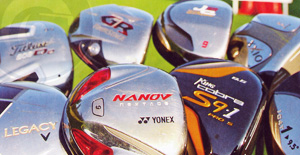 Who isn’t always looking for a longer and straighter driver? Finding the best performing driver unfortunately is not an easy thing. With so many models and shafts and specs, the first step is of course getting fit and knowing your swing. After that it comes down to getting the right pieces to create your driving machine. The quest can be never ending as we always want more distance, more feel, more control.
Who isn’t always looking for a longer and straighter driver? Finding the best performing driver unfortunately is not an easy thing. With so many models and shafts and specs, the first step is of course getting fit and knowing your swing. After that it comes down to getting the right pieces to create your driving machine. The quest can be never ending as we always want more distance, more feel, more control.
It’s not easy finding the right driver…
I’m the same as the next golf enthusiast and I admit I have changed drivers more than I should in my quest to find the greatest big stick. Sometimes I find it even more difficult because I live in Japan and test golf equipment regularly. Believe it or not this makes the decisions even harder. The funny thing is I study about all the products in Japan and test all the products so that I can make educated recommendations to all our customers but the hardest person to fit is… myself. I speak to the manufacturers about their products, study all the literature, read every golf publication in Japan and best of all try all the equipment as nothing will explain feel and performance more than actually trying the club. All this so I can relay what I know to the people who contact me about the products we offer from Japan.
Crazy Shafts…
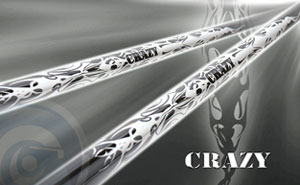 So I thought I would take the opportunity to explore a new build with Crazy Shaft. As you’ve read on the blog, Crazy has been rising the ranks very quickly in Japan among premium aftermarket golf shaft brands. What began a few years ago as a cult following of long drivers and hard hitters has become a dedicated fanbase of enthusiast golfers who are willing to pay a premium for the best quality carbon and best performing shafts with a cool brand to boot.
So I thought I would take the opportunity to explore a new build with Crazy Shaft. As you’ve read on the blog, Crazy has been rising the ranks very quickly in Japan among premium aftermarket golf shaft brands. What began a few years ago as a cult following of long drivers and hard hitters has become a dedicated fanbase of enthusiast golfers who are willing to pay a premium for the best quality carbon and best performing shafts with a cool brand to boot.
Click read more to find out about this project!
Premium Carbon = Premium Performance
For those of you not familiar with Crazy Shaft, they are a brand that believes in creating the best performing shafts only from the best carbon available in Japan. Crazy uses 80t and 50t full sheets of carbon in their top model shafts. So how does carbon grading work? Shafts are created with carbon fibers weaved together, and these fibers are measured by their modulus of elasticity in tension. Typical golf shafts are around 24t or 30t, the measurement of tensile strength. These grade shafts are more flexible and because of this the shaft is slow to regain its original shape on the downswing creating inconsistent impact where a player must rely heavily on timing due to the flexibility of the shaft. As the tensile strength increases the carbon weaves are more dense, more rigid and return more quickly to their original shape.
The flex and rebound of the shaft becomes more predictable equaling more consistent shots and much tighter dispersion. The higher tensile ratings ratings in golf shafts are also related to the higher grades containing more glass and metal particles which are more rigid and lower grades containing more flexible rubber particles. Crazy’s Black 80 uses 80t and Crazy’s Black 50 uses 50t carbon while the Crazy Longest yard is a shaft using 45t, 46t and 40t grade carbon all higher than typical graphite shafts on the market today. Higher grade carbon also equals higher pricing with many of these models being priced from 500.00 to 800.00 USD. Regardless of the high prices, it appears that Japanese golfers are ready to spend on getting the right shaft for their clubs no matter what the cost.
Finding a driver head’s soulmate… impossible task?
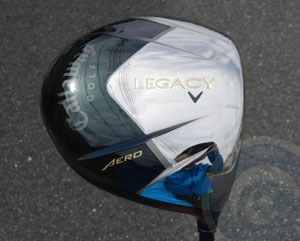 I’ve decided to use this build not only to try and create the longest and straightest driver I have ever owned but to learn more about Crazy Shaft and how the feel and perform. I believe that having the right shaft and right head combo is very important. A good driver head can become pretty bad with the wrong shaft in there while an average head can become quite great with an amazing shaft in it. Finding this pairing and what fits an individual’s swing is not easy by any means.
I’ve decided to use this build not only to try and create the longest and straightest driver I have ever owned but to learn more about Crazy Shaft and how the feel and perform. I believe that having the right shaft and right head combo is very important. A good driver head can become pretty bad with the wrong shaft in there while an average head can become quite great with an amazing shaft in it. Finding this pairing and what fits an individual’s swing is not easy by any means.
2009 Distance Champion: The Legacy Aero
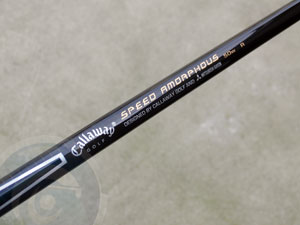 I’ve tried and hit probably 40+ drivers in the last 2 years, so choosing a head was very hard to do. I thought of using a Crazy head or maybe Kamui but these are not brands golfers outside of Japan are familiar with so I decided to go with a mainstream brand in the 2009 Callaway Legacy Aero driver. The Legacy line is a Japan line that has done very very well with all levels of golfers. The Legacy drivers are all premium Titanium, forged at Endo, creating drivers with very soft feel and great performance. As a matter of a fact, the Legacy Aero is Golf Digest Japan’s 2009 D1 Driver Distance Champion. The D1 features 64 of the years top retail drivers including US and Japanese brands and the Legacy Aero’s combination of a mid penetrating trajectory and low spin made it the overall champion. I also chose this model as it suits my level of play and style. I am the typical average golfer in Japan, swinging just under 90mph and driving the ball around 220y with a hard time battling the right side. Sometimes over compensation in avoiding the slice creates unwanted hooks. The Aero has enough forgiveness for me to handle and features a mid shallow face with forgiveness off the toe and heel. The club I chose also had a slightly closed face of around 0.5*.
I’ve tried and hit probably 40+ drivers in the last 2 years, so choosing a head was very hard to do. I thought of using a Crazy head or maybe Kamui but these are not brands golfers outside of Japan are familiar with so I decided to go with a mainstream brand in the 2009 Callaway Legacy Aero driver. The Legacy line is a Japan line that has done very very well with all levels of golfers. The Legacy drivers are all premium Titanium, forged at Endo, creating drivers with very soft feel and great performance. As a matter of a fact, the Legacy Aero is Golf Digest Japan’s 2009 D1 Driver Distance Champion. The D1 features 64 of the years top retail drivers including US and Japanese brands and the Legacy Aero’s combination of a mid penetrating trajectory and low spin made it the overall champion. I also chose this model as it suits my level of play and style. I am the typical average golfer in Japan, swinging just under 90mph and driving the ball around 220y with a hard time battling the right side. Sometimes over compensation in avoiding the slice creates unwanted hooks. The Aero has enough forgiveness for me to handle and features a mid shallow face with forgiveness off the toe and heel. The club I chose also had a slightly closed face of around 0.5*.
The Right Head and Shaft for the Swing
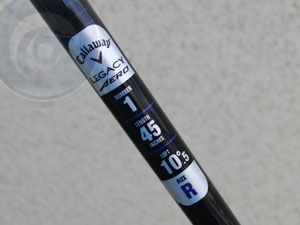 The Legacy Aero comes in two models, a 46″ and a 45″ model. I chose the 45″ because I wanted a heavier head and did not plan on going over 45″ in length. The stock Legacy Aero shaft is a Callaway Speed Amorphous 50w designed by Mitsubishi Rayon. Of all the golf brands in Japan, I find Callaway stock shafts to be on the soft side. I do like a soft shaft because it gives me the most feel and I believe the most distance as long as I can control it. The hard part about choosing an aftermarket shaft is not only the right model but also flex. There are no standards among manufacturers when it comes to flex and a Regular flex in one brand is not necessarily a Regular flex in another. Too many people simply equate flex to swing speed but there is so much more to it that just how fast you swing the club. It’s how you swing it and the results you produce because of that swing and the results you want. What you do and what you want can be two very different things.
The Legacy Aero comes in two models, a 46″ and a 45″ model. I chose the 45″ because I wanted a heavier head and did not plan on going over 45″ in length. The stock Legacy Aero shaft is a Callaway Speed Amorphous 50w designed by Mitsubishi Rayon. Of all the golf brands in Japan, I find Callaway stock shafts to be on the soft side. I do like a soft shaft because it gives me the most feel and I believe the most distance as long as I can control it. The hard part about choosing an aftermarket shaft is not only the right model but also flex. There are no standards among manufacturers when it comes to flex and a Regular flex in one brand is not necessarily a Regular flex in another. Too many people simply equate flex to swing speed but there is so much more to it that just how fast you swing the club. It’s how you swing it and the results you produce because of that swing and the results you want. What you do and what you want can be two very different things.
Choosing the Right Flex for Crazy
Crazy Shaft are made for the player with power and that can make good contact on the ball in other words those who can create good smash factor. They are not for the player with slow tempo and glancing blows at impact. Because of these so called requirements from Crazy I initially deemed myself unworthy of playing a Crazy shaft. I finally decided to give them a shot after working with them for a month and coming to the conclusion that they must offer R2 and R3 flexes for a reason. R2 and R3 are a step or 2 below Regular flex softness wise. One thing I had to keep in mind though is that the flex designations on Crazy Shafts are up to a flex or MORE stiffer than typical brands on the market today. While R2 and R3 are supposedly considered senior flexes or soft R flexes, they are in fact stouter than most Regular flex shafts on the market. This goes for the entire shaft range at Crazy.
The Longest Yard… I hope to join Drakon^^…
I eventually settled on a Longest Yard 01 model with R2 Flex. Longest yard is Crazy’s distance shaft originally inspired and made for the long drive contests (DRAKON) in Japan but then expanded and designed for the retail market but providing the same type of distance performance. In Gakuen Mook’s Shaft Bible, an intense publication testing all the top shafts in Japan from every brand (Japanese and American), the Longest Yard 01 was the longest performing shaft distance wise (all shafts used with the same head and grip built to the same length). The LY-01 is the model made for the hitter battling a hook while the 02 is for the swinger and those battling a slice. Torque numbers are higher in the Longest Yard series but this does NOT equal a whippy shaft. A lot of people always freak out over torque numbers in the high 4’s and 5’s but all that really equates to is more feel and more help from the shaft at squaring the head at impact. Torque is not necessarily a bad thing, it all depends on the player. Actual specs of the LY-01 R2 are as follows: 5.9kg flex, 53 gram weight, 5.2* of torque and a mid kick. I’m hoping the LY-01’s distance performance coupled with its stouter profile and premium grade 45t carbon equal control as well. I decided on the LY-01 because after much analysis of my own swing, I have come to the conclusion that while my tempo is average, my transition is rather aggressive leaving the club head lagging behind and open resulting in a push right. As I try and adjust my timing it leads to pulls and hooks. We will see if the LY-01 works or I should have gone for the 02. I am keeping my fingers crossed that the higher grade carbon eliminates the need for me to time impact and I can just swing away.
Stay Tune for Part 2…
So I’ve got all my parts and will check CPM’s before and after as well as document this build and testing along the way. This is just part 1 so I will comment more about the Crazy shafts and the Legacy head as we go along. I’m hoping this will be an ongoing project with lots of interesting performance results but most of all long and straight drives that keep me in the center of the fairway. Stay tuned for part 2 once I get to the shop.


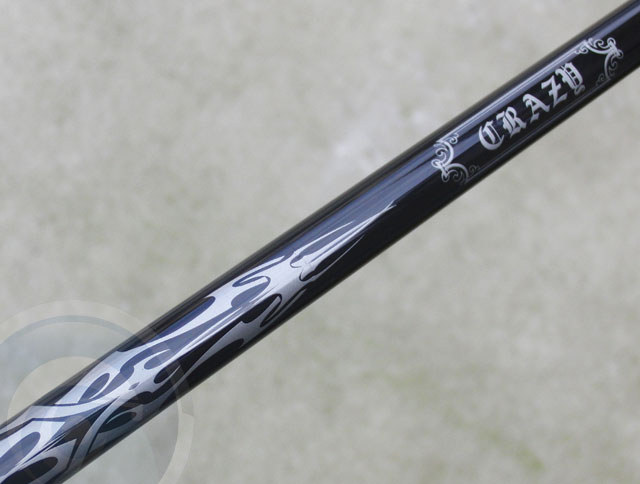
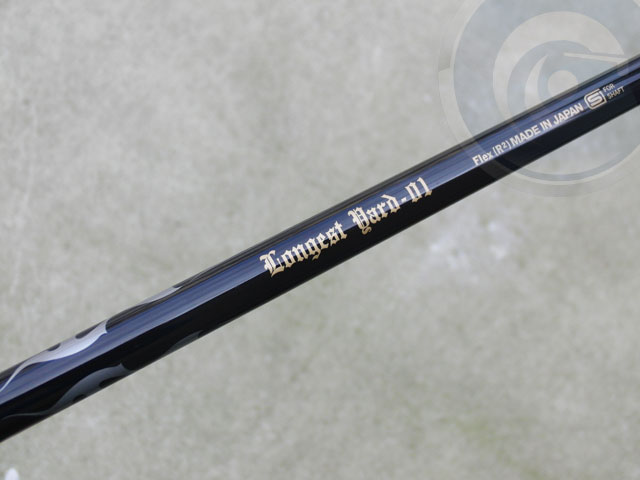










Comments 3